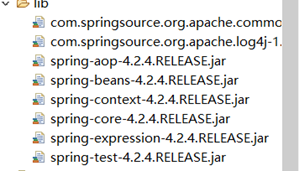一、 使用注解配置Spring步骤
第一步:导包(4+2)四个核心包,一个日志包+aop包
第二步:为主配置文件引入新的命名空间(约束)

随后

第三步:书写applicationContext.xml
<?xml version="1.0" encoding="UTF-8"?>
<beans xmlns:xsi="http://www.w3.org/2001/XMLSchema-instance"
xmlns="http://www.springframework.org/schema/beans"
xmlns:context="http://www.springframework.org/schema/context"
xsi:schemaLocation="http://www.springframework.org/schema/beans
http://www.springframework.org/schema/beans/spring-beans-4.2.xsd http://www.springframework.org/schema/context
http://www.springframework.org/schema/context/spring-context-4.2.xsd ">
<!-- 指定扫描com.aiit.bean根下的所有类中的注解
注意:扫描包时,会扫描指定包下的所有子孙包
-->
<context:component-scan base-package="com.aiit.bean"></context:component-scan>
</beans>
第四步:在类中使用注解完成配置
二、 使用注解
在类名上使用以下属性,也可以使用Scope属性,设置作用范围
1. 使用注解将对象注册到容器中
@Component("user")@Service("user")//service层@Controller("user")//web层@Repository("user")//dao层- Scope属性
prototype:多例singleton:单例(默认)
@Component("user")
//<bean name ="user" class="com.aiit.bean"/>
// @Service("user") //service层
// @Controller("user") //web层
// @Repository("user") //dao层
@Scope(scopeName = "prototype")
public class User {}
2. 使用注解将值类型注入
当传入普通属性值
方式一:在属性上使用@Value
public class User {
@Value("tom")
private String name;
}
方式二:在Set方法上使用@Value
public class User {
private String name;
@Value("tom")
public void setName(String name) {
this.name = name;
}
}
当传入引用数据类型
方式一:使用@Autowired注解,表示自动装配
该方式常配合使用@Qualifier,用以表示指定引用类型
@Autowired//自动装配
//问题:如果匹配多个类型一致的对象,将无法选择具体装入哪一个对象
@Qualifier("car2") //使用@Qualifier注解告诉spring容器自动装配哪个名称的对象
private Car car;
由此会引出问题,当我们使用多个对象的时候,就不清楚使用哪个对象。所以这两个配置常常混合使用
方式二:使用@Resource()//手动注入,指定注入哪个名称的对象
@Resource(name="car2")//手动注入,指定注入哪个名称的对象
private Car car;
3. 初始化和销毁方法
使用注解@PostConstruct 和@PreDestroy
@PostConstruct //在对象被创建后调用init-method
public void Init() {
System.out.println("我是初始化方法");
}
@PreDestroy //在对象销毁之后调用destory-method
public void destory() {
System.out.println("我是销毁方法");
}
相当于使用如下配置
<bean name="user" class="com.aiit.bean.User" init-method="init" destroy-method="destory"></bean>
三、 Spring与Junit整合测试
第一步:导包(4+2+aop+test)

第二步:配置注解
@RunWith(SpringJUnit4ClassRunner.class)//帮我们创建容器
@ContextConfiguration("classpath:applicationContext.xml")//指定创建容器时使用哪个配置文件
public class Demo {
//将名为user的对象注入到u变量中
@Resource(name = "user")
private User u;
@Test
public void fun1() {
System.out.println(u);
}
}
第三步:测试
public class Demo {
//将名为user的对象注入到u变量中
@Resource(name = "user")
private User u;
@Test
public void fun1() {
System.out.println(u);
}
}
四、 AOP思想
1. Spring的aop概念
- aop,即为面向切面编程。纵向代码,横向抽取。
- Spring能够为容器中管理的对象生成动态代理对象
- Spring能够帮我们生成代理对象
2. Spring实现aop原理
-
JDK的动态代理(优先):针对实现了接口的类产生代理
-
Cglib的动态代理(没有接口):针对没有实现接口的类产生代理,应用的是底层的字节码增强技术,生成当前类的子类对象。也就是说对目标对象继承代理。但是如果目标对象被final修饰,那么该类无法被cglib代理。
3. JDK动态代理
第一步,我们书写一个接口并实现接口
public interface UserService {
void save();
void delete();
void update();
void find();
}
public class UserServiceImpl implements UserService{
@Override
public void save() {
System.out.println("保存用户");
}
@Override
public void delete() {
System.out.println("删除用户");
}
@Override
public void update() {
System.out.println("更新用户");
}
@Override
public void find() {
System.out.println("查找用户");
}
}
第二步:对UserServiceImpl 进行增强,我们在增删改查用户的时候,在之前要设置开启事务,在操作完毕之后设置事务提交。
public class UserServiceProxyFactory implements InvocationHandler{
private UserService us;
public UserServiceProxyFactory(UserService us) {
super();
this.us = us;
}
public UserService getUserServiceProxy() {
//生成动态代理
UserService usProxy = (UserService) Proxy.newProxyInstance(UserServiceProxyFactory.class.getClassLoader(),
UserServiceImpl.class.getInterfaces(),
this);
//返回
return usProxy;
}
@Override
public Object invoke(Object proxy, Method method, Object[] args) throws Throwable {
System.out.println("打开事务");
Object invoke = method.invoke(us, args);
System.out.println("提交事务");
return invoke;
}
}
第三步:做测试
public class Demo {
@Test
public void fun1() {
UserService us =new UserServiceImpl();
UserServiceProxyFactory factory =new UserServiceProxyFactory(us);
UserService usProxy = factory.getUserServiceProxy();
usProxy.delete();
}
}
4. cglib动态代理
其余的东西与JDK代理类似,主要是看代理的方法
public class UserServiceProxyFactory2 implements MethodInterceptor{ //Callback子类
public UserService getUserServiceProxy() {
Enhancer enhancer =new Enhancer();//帮我们生成代理对象
enhancer.setSuperclass(UserServiceImpl.class); //对谁进行代理
enhancer.setCallback(this); //代理要做什么
UserService us =(UserService) enhancer.create();//创建代理对象
return us;
}
@Override
public Object intercept(Object prxoyobj, Method method, Object[] arg, MethodProxy methodProxy) throws Throwable {
// TODO Auto-generated method stub
//打开事务
System.out.println("打开事务");
//调用原有方法
Object returnValue = methodProxy.invokeSuper(prxoyobj, arg);
//提交事务
System.out.println("提交事务");
return returnValue;
}
}
测试代码
@Test
public void fun2() {
UserServiceProxyFactory2 factory =new UserServiceProxyFactory2();
UserService usProxy = factory.getUserServiceProxy();
usProxy.save();
//判断代理对象是否属于被代理对象类型
//代理对象继承了被代理对象
System.out.println(usProxy instanceof UserServiceImpl);
}
两次打印结果为true

五、 AOP名词学习
Joinpoint(连接点):所谓连接点是指那些被拦截到的点。在 spring 中,这些点指的是方法,因为 spring 只 支持方法类型的连接点.Pointcut(切入点):所谓切入点是指我们要对哪些 Joinpoint 进行拦截的定义。(目标对象已经增强的方法,例如:方法中的增删进行增强,但是改查没有进行增强,那么增删就是切入点),也可以说,我们即将需要加强的方法Advice(通知/增强):所谓通知是指拦截到 Joinpoint 之后所要做的事情就是通知.通知分为前置通知,后置 通知,异常通知,最终通知,环绕通知(切面要完成的功能) ,也就是增强的代码。如:打开事务,或关闭事务Introduction(引介):引介是一种特殊的通知在不修改类代码的前提下, Introduction 可以在运行期为类 动态地添加一些方法或 Field.Target(目标对象):代理的目标对象。被代理的对象Weaving(织入):是指把增强应用到目标对象来创建新的代理对象的过程. spring 采用动态代理织入,而 AspectJ 采用编译期织入和类装在期织入 。将通知应用到切入点的过程就是织入。Proxy(代理:一个类被 AOP 织入增强后,就产生一个结果代理类 Aspect(切面): 是切入点和通知(引介)的结合aspect(切面):切入点+通知
六、 Spring的aop准备工作
1.导包(4+2+2+2)
4:四个核心包 2:两个日志包 2:(aop+aspect) 2:(aop联盟包+weaver包)

2. 准备目标对象
3.准备通知
4.配置进行织入,将通知织入目标对象中
七、spring中的aop代码实现
2.准备目标对象
public interface UserService {
void save();
void delete();
void update();
void find();
}
public class UserServiceImpl implements UserService{
@Override
public void save() {
System.out.println("保存用户");
}
@Override
public void delete() {
System.out.println("删除用户");
}
@Override
public void update() {
System.out.println("更新用户");
}
@Override
public void find() {
System.out.println("查找用户");
}
}
3.准备通知
public class MyAdvice {
//前置通知
// |-目标方法运行之前调用
//后置通知(如果出现异常不回调用)
// |-目标方法运行之后调用
//环绕通知
// |-目标方法运行之前和之后都调用
//异常拦截通知
// |-目标方法运行之前调用
//后置通知(无论是否出现异常都会调用)
// |-目标方法运行之后调用
//--------------------------------------------------------
//前置通知
public void before() {
System.out.println("这是前置通知");
}
//后置通知
public void afterReturning() {
System.out.println("这是后置通知(如果出现异常不会调用)");
}
//环绕通知
public Object around(ProceedingJoinPoint pjp) throws Throwable {
System.out.println("这是环绕通知之前的部分");
Object proceed = pjp.proceed(); //调用目标方法
System.out.println("这是环绕通知之后的部分");
return proceed;
}
//异常拦截通知
public void afterExpection() {
System.out.println("出现异常!");
}
//后置通知
public void after() {
System.out.println("这是后置通知(如果出现异常也会调用)");
}
}
4.进行配置
<?xml version="1.0" encoding="UTF-8"?>
<beans xmlns:xsi="http://www.w3.org/2001/XMLSchema-instance"
xmlns="http://www.springframework.org/schema/beans"
xmlns:context="http://www.springframework.org/schema/context"
xmlns:aop="http://www.springframework.org/schema/aop"
xsi:schemaLocation="http://www.springframework.org/schema/beans
http://www.springframework.org/schema/beans/spring-beans-4.2.xsd
http://www.springframework.org/schema/context http://www.springframework.org/schema/context/spring-context-4.2.xsd http://www.springframework.org/schema/aop
http://www.springframework.org/schema/aop/spring-aop-4.2.xsd ">
<!-- 准备工作: 导入aop(约束)命名空间 -->
<!-- 1.配置目标对象 -->
<bean name="userService" class="com.aiit.service.UserServiceImpl" ></bean>
<!-- 2.配置通知对象 -->
<bean name="myAdvice" class="com.aiit.aspect.MyAdvice" ></bean>
<!-- 3.配置将通知织入目标对象 -->
<aop:config>
<!-- 配置切入点
public void com.aiit.service.UserServiceImpl.save()
void com.aiit.service.UserServiceImpl.save()
* com.aiit.service.UserServiceImpl.save() //返回类型任意
* com.aiit.service.UserServiceImpl.*() //UserServiceImpl类中的所有方法且返回值任意但必须为空参函数
* com.aiit.service.UserServiceImpl.*(..) //UserServiceImpl类中的所有方法且返回值任意可以传入多个参数
* com.aiit.service.*ServiceImpl.*(..) //所有以ServiceImpl为结尾的类名下的所有方法且方法返回值任意,参数任意
-->
<aop:pointcut expression="execution(* com.aiit.service.UserServiceImpl.*(..)" id="pc"/>
<aop:aspect ref="myAdvice" >
<!-- 指定名为before方法作为前置通知 -->
<aop:before method="before" pointcut-ref="pc" />
<!-- 后置 -->
<aop:after-returning method="afterReturning" pointcut-ref="pc" />
<!-- 环绕通知 -->
<aop:around method="around" pointcut-ref="pc" />
<!-- 异常拦截通知 -->
<aop:after-throwing method="afterException" pointcut-ref="pc"/>
<!-- 后置 -->
<aop:after method="after" pointcut-ref="pc"/>
</aop:aspect>
</aop:config>
</beans> <aop:before method="before" pointcut-ref="pc" />
<!-- 后置 -->
<aop:after-returning method="afterReturning" pointcut-ref="pc" />
<!-- 环绕通知 -->
<aop:around method="around" pointcut-ref="pc" />
<!-- 异常拦截通知 -->
<aop:after-throwing method="afterException" pointcut-ref="pc"/>
<!-- 后置 -->
<aop:after method="after" pointcut-ref="pc"/>
</aop:aspect>
</aop:config>
</beans>
此处注意:我们在配置切入点表达式的时候
public void com.aiit.service.UserServiceImpl.save()
void com.aiit.service.UserServiceImpl.save()
* com.aiit.service.UserServiceImpl.save() //返回类型任意
* com.aiit.service.UserServiceImpl.*() //UserServiceImpl类中的所有方法且返回值任意但必须为空参函数
* com.aiit.service.UserServiceImpl.*(..) //UserServiceImpl类中的所有方法且返回值任意可以传入多个参数
* com.aiit.service.*ServiceImpl.*(..) //所有以ServiceImpl为结尾的类名下的所有方法且方法返回值任意,参数任意
<aop:pointcut expression="execution(* com.aiit.service.UserServiceImpl.*(..)" id="pc"/>
5.代码测试
@RunWith(SpringJUnit4ClassRunner.class)
@ContextConfiguration("classpath:com/aiit/aspect/applicationContext.xml")
public class Demo {
@Resource(name = "userService")
private UserService us;
@Test
public void fun1() {
us.save();
}
}
八、使用注解使用AOP
第一步:在xm文件中写注释
<!-- 准备工作: 导入aop(约束)命名空间 -->
<!-- 1.配置目标对象 -->
<bean name="userService" class="com.aiit.service.UserServiceImpl" ></bean>
<!-- 2.配置通知对象 -->
<bean name="myAdvice" class="com.aiit.aspect.MyAdvice" ></bean>
<!-- 3.配置将通知织入目标对象 -->
<aop:aspect-autoproxy></aop:aspect-autoproxy>
</beans>
第二步:在通知类中书写注释
@Aspect
public class MyAdvice {
@Pointcut("execution(* com.aiit.service.*ServiceImpl.*(..))")
public void pc() {
}
//前置通知
//指定该方法时前置通知,并指定切入点
@Before("MyAdvice.pc()")
public void before() {
System.out.println("这是前置通知");
}
//后置通知
@AfterReturning("MyAdvice.pc()")
public void afterReturning() {
System.out.println("这是后置通知(如果出现异常不会调用)");
}
//环绕通知
@Around("MyAdvice.pc()")
public Object around(ProceedingJoinPoint pjp) throws Throwable {
System.out.println("这是环绕通知之前的部分");
Object proceed = pjp.proceed(); //调用目标方法
System.out.println("这是环绕通知之后的部分");
return proceed;
}
//异常拦截通知
@AfterThrowing("MyAdvice.pc()")
public void afterExpection() {
System.out.println("出现异常!");
}
//后置通知
@After("MyAdvice.pc()")
public void after() {
System.out.println("这是后置通知(如果出现异常也会调用)");
}
}
























 1万+
1万+











 被折叠的 条评论
为什么被折叠?
被折叠的 条评论
为什么被折叠?








